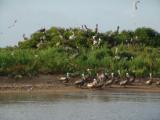The Recovery of the Brown Pelican by Brent Ortega
Their primary food is fish and they typically catch them by plunging into the water. Views of them perched, diving into the gulf or gliding just above the waves are one of the most common wildlife scenes along the Coast. It would be unusual to find a location where they do not occur today. Few people remember when they were rare and placed on the federal endangered species list in 1973.
The recovery of the Brown pelican population is a wildlife success story. There were about 5,000 in Texas when scientists started tracking their status in the early 1900's. The population started to decline in the 1920's when the species was persecuted for competing with commercial fishing. It declined further after World War II when the use of potent pesticides like endrin and DDT became prevalent in fighting pests in agricultural fields. (Endrin was toxic to the pelican. DDT caused eggshell thinning in pelicans and a number of avian species resulting in low production of young.) The population reached its lowest level in 1964 when there were only 50 birds reported on the Texas coast.
The Brown pelican was placed on the Endangered Species List in 1973, and use of pesticides was highly restricted afterwards. The population started to slowly increase.
There were only six nesting pairs in 1973 when the Texas Colonial Waterbird Society—a partnership between Coastal Bend Bays & Estuaries Program, National Audubon Society, Texas A&M University, Texas General Land Office, Texas Parks & Wildlife Department, and U.S. Fish & Wildlife Service—started conducting annual nest surveys. The population increased to 75 pairs in 1983, 530 pairs in 1993, and 3,706 pairs in 2003. There were 3,051 pairs when the species was removed from the federal threatened and endangered species list in 2009. The last nesting survey in 2012 reported 8,115 nesting pairs from 11 colonies. This is a remarkable recovery from a species that went from 5,000 birds in the early 1900's to 50 birds in 1964, and then increased to more than 20,000 birds today.
Major threats today are chemical spills, disturbance at nesting colonies by humans, and predation at nesting colonies by coyotes, feral hogs, fire ants and raccoons. Pelicans can be easily spooked off of nests by people making their eggs and young vulnerable to predators and the elements. Anglers and bay users are encouraged to stay at least 50 yards away from nesting islands.
I was musing the history of their populations this spring while conducting research on Padre Island National Seashore when our team observed more than 4,000 Brown pelicans flying north in one day. The Texas bays and estuaries are obviously healthy enough today to provide for a thriving population of Brown pelicans for many years to come.
Brent Ortego is the Texas Parks and Wildlife Department’s diversity biologist in Region 7 working out of Victoria, Tex.





